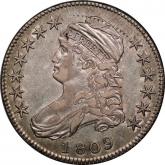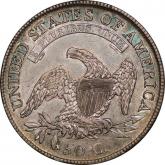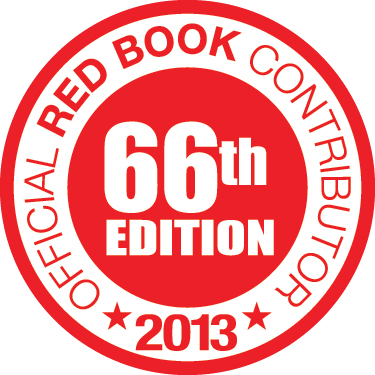Ex Mike Biggs and Charlton E. Meyer, Jr.
Henry’s note to posterity: Incused segments across cap on obverse, indicating a second strike by the die. From the Charlton Meyer collection, and purchased by me from Sheridan Downey’s “Selected Rarities” sale at the ANA in July 2008, lot #24. See full page write-up of this coin and the history of the “1809-O-107a” on p. 23 of that catalog.
Description of Lot 24, Meyer Collection Catalog
Here is one for the old timers, those who cut their teeth on Overton’s 1970 2nd edition. Hearken to those days of yesteryear when there were two sub-varieties everyone lacked,
1809 O.107a and
1818 O.111a. Each “sub-variety,” of course, is better described as a mint error, having nothing to do with progressive changes in or deterioration of the dies. Describing the 1818 O.111a (O.25, 1st ed., 1967) Overton was forthright in calling it a double strike. When it came to the 1809 O.107a (O.20 1st ed.), however, he led us astray, suggesting that an intermediate stage of the obverse die came with, “… a curved row of small, incused segments or triangles from above star 7 across top of cap to star 8.”
Dr. Gerald Schertz sounded the death knell of the 107a when his article, “
A Screw Loose in 1809?” appeared in Vol. 2, Issue 3 of the December 1987
John Reich Journal. Dr. Schertz managed to find two so-called 107a’s. The placement of the rows of segments differed; and the reverses were from different stages of the die. He concluded that the 107a did not exist as a die state. But just how did the incused segments arrive on these coins if the die was not injured? Dr. Schertz postulated that on rare occasions a blank planchet might be only partially inserted in the coining chamber, perhaps resting at an angle on the open collar. When the hammer die descended the “… attempted strike would incuse segments from the lateral margin of one die in an arc across the planchet.” That planchet would then be retrieved, centered in the collar and properly struck - but with insufficient force to obliterate the segments. It seems fair to ask whether the segments might have occurred
after a full strike. Perhaps the coin was only partially ejected or was still centered in the collar when an inadvertent throw or drop of the screw occurred.
Meyer picked up his “107a” in July 1987 from BHNC member Mike Biggs. It was accompanied by Biggs’ 1829 MB-1 [O.120], the discovery piece. The “107a” is an early die state, sharply struck, primarily grey with hints of kraft toning and some unobtrusive hairlines. Today’s attribution would be O.107 R.4, double struck. The provenance and lore it brings to the next owner is priceless!
Estimate: $1,000 and up



